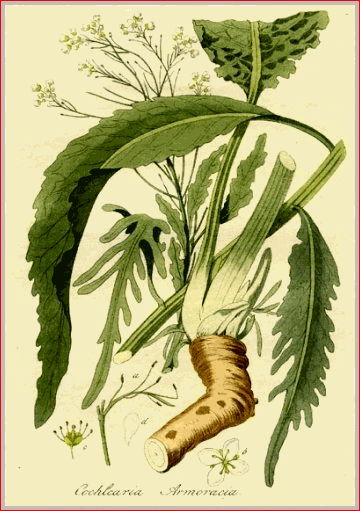
 ARMORACIAE
RADIX. Br. HORSERADISH ROOT
ARMORACIAE
RADIX. Br. HORSERADISH ROOT
Martindale�s 24th Br.
Boerickes Homeopathic Materia Medica.
Compiled by Ivor Hughes
ARMORACIAE RADIX. Br. HORSERADISH ROOT
Armoracia, Br. 1864; Radix Raphani Rusticani Raifort Pr. Cod.; Moutarde des Moines, Radis de Cheval, Cran de Bretagne, Fr.;Meerrettig, G.;Rabanorusticano (Raizde),Sp.
Cochleria Armoracia L. (also known as Roripa Armoracia L., Hitch, and Radicula Armoracia L., Robinson) a member of the Cruciferae, is a native of the marshy districts of Eastern Europe. It is cultivated very largely for its roots which are used as a condiment, being considered stimulating to the digestive organs. It has escaped from our gardens, growing in moist grounds, especially along streams. The root of this plant is perennial, sending up numerous very large radical leaves from the midst of which a round, smooth, erect, branching stem rises two or three feet in height. The radical leaves are lance-shaped, wavy scalloped on the edges, sometimes pinnatifid, and stand upon strong footstalks; those of the stem are much smaller, oblong or lanceolate, sessile, sometimes divided at the edges, sometimes almost entire. The flowers are white, and arranged in terminal and axillary panicles of racemes. The fruit is a silicle
The root, which is most active in early spring and autumn, is long, conical at top, then nearly cylindrical for some inches, at last tapering, of a strong, pungent, odor when scraped or
bruised, and of a hot, biting, somewhat sweetish, and sometimes bitterish taste. "Nearly cylindrical, except at the crown, where it is somewhat enlarged, and marked with closely approximated semi-amplexicaul leaf-scars. Diameter from twelve to twenty-five millimetres, length commonly thirty centimetres or more; pale yellowish-white or brownish-white externally, whitish within. Inodorous when unbroken, but yielding a characteristic pungent odor when scraped or bruised; taste very pungent." Br.Its virtues depend upon a volatile oil, which is dissipated by drying, the root becoming at first sweetish, and ultimately insipid and quite inert. Its acrimony is also destroyed by boiling. The oil may be obtained by distillation with water. It is colorless or pale yellow, heavier than water, very volatile, excessively pungent, acrid, and corrosive, exciting inflammation and even vesication when applied to the skin. Hubatka considers it as identical with the volatile oil of mustard. He combined it with ammonia and obtained crystals of thiosinamin. NH2.CS.N(C3H5)H, which agreed with that produced from mustard oil. (J. P. C., 3e ser., v, 42.) According to Gutret, only six parts of it are obtained from 10,000 of the root. Besides this principle, the fresh root contains, according to the same chemist, a little resin in minute quantity, sugar, extractive, gum, starch, albumen, acetic acid, calcium sulphate and acetate, water and lignin. From observations made by F. L. Winckler, it may be inferred that like mustard it contains potassium myronate which in the presence of water is decomposed by an enzyme, also existing in the root, and water, to produce the volatile oil. (See Sinapis.) Horseradish when distilled with alcohol yields none of the oil. Buried in cool sand the root may be kept for some time without material deterioration.
It is said that if to the powder of the dried root which has become apparently inert, the emulsion of white mustard seed containing myrosin be added, it re-acquires its original irritant properties; so that it is the ferment myrosin and not the potassium myronate which is injured by drying. Hence the powdered root may be added with advantage to mustard in preparing cataplasms, pediluvia, etc. (J. P. C., xxvii, 268.)
The French Codex contains a formula for compound syrup of horseradish under the name of Sirop de Raifort Compose. It was formerly called Sirop Antiscorbutique.
Uses. � Horseradish is highly stimulant, exciting the stomach when swallowed, and promoting the secretions, especially that of urine. Externally it is rubefacient. Its chief use is as a condiment to promote appetite and invigorate digestion.
Dose,
fifteen to thirty grains (1-2 Gm.) or more, grated or cut into small pieces.Off. Prep. � Spiritus Armoraciae Compositus.
Martindale�s Extra Pharmacopoeia 24th Edition
Boericke's Homoeoptahic Materia Medica.
COCHLEARIA
ARMORACIA � ARMORACIA SATIVA (Horse-radish)
Frontal bone and sinus, antrum and salivary glands are specifically affected
by this drug. Bloated sensation. Raises vital forces. Used as a gargle in
scorbutic gums and sore throat. Hoarseness and in relaxed conditions of the
fauces. Internally in gonorrhoaa. Useful as a condiment in enfeebled states
of the stomach. An infusion of the root in cider, for dropsy, causes copious
diuresis. Locally cures dandruff.
Head. � Thinking is difficult. Anxiety, driven to despair by pain.
Pressing, boring pain as if frontal bone would fall out. Violent headache
with vomiting. Impaired hearing.
Eyes. � Sore and scrofulous; traumatic inflammation of eyes,
blearedness and cataract. Copious running from eyes.
Stomach. � Pain towards back; worse, pressure on dorsal vertebrae.
Belching and cramps. Colic with backache. Violent cramp from, stomach
through both sides around to back. Griping around navel.
Back. � Pain in back as from incarcerated flatulence from abdomen
through to back and down into sacrum.
Respiratory. � Dry, hacking, laryngeal cough, also post-influenzal
cough, dry or loose, worse lying down. Chest painful to touch. Coryza, with
hoarseness. Mucous asthma. (Edema of lungs. Throat feels rough and
hoarse.
Urinary. � Burning and cutting at glans penis before, during, and
after urination. Frequent urination.
Modalities.� Worse evening and at night.
Relationship.� Compare: Cannab; Sinapis; Caps.
Dose.�First to third attenuation.
If you did not find what you were seeking use the
site search box at the top right hand of the page.
![]()